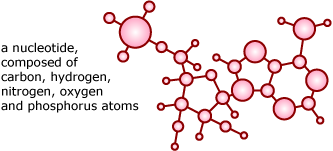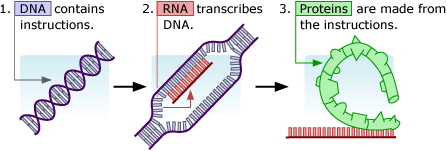Living things (even ancient organisms like bacteria) are enormously complex. However, all this complexity did not leap fully-formed from the primordial soup. Instead life almost certainly originated in a series of small steps, each building upon the complexity that evolved previously:
1. Simple organic molecules were formed.
Simple organic molecules, similar to the nucleotide shown below, are the building blocks of life and must have been involved in its origin. Experiments suggest that organic molecules could have been synthesized in the atmosphere of early Earth and rained down into the oceans. RNA and DNA molecules — the genetic material for all life — are just long chains of simple nucleotides.

2. Replicating molecules evolved and began to undergo natural selection.
All living things reproduce, copying their genetic material and passing it on to their offspring. Thus, the ability to copy the molecules that encode genetic information is a key step in the origin of life — without it, life could not exist. This ability probably first evolved in the form of an RNA self-replicator — an RNA molecule that could copy itself.

Many biologists hypothesize that this step led to an “RNA world” in which RNA did many jobs, storing genetic information, copying itself, and performing basic metabolic functions. Today, these jobs are performed by many different sorts of molecules (DNA, RNA, and proteins, mostly), but in the RNA world, RNA did it all.
Self-replication opened the door for natural selection. Once a self-replicating molecule formed, some variants of these early replicators would have done a better job of copying themselves than others, producing more “offspring.” These super-replicators would have become more common — that is, until one of them was accidentally built in a way that allowed it to be a super-super-replicator — and then, that variant would take over. Through this process of continuous natural selection, small changes in replicating molecules eventually accumulated until a stable, efficient replicating system evolved.
3. Replicating molecules became enclosed within a cell membrane.
The evolution of a membrane surrounding the genetic material provided two huge advantages: the products of the genetic material could be kept close by and the internal environment of this proto-cell could be different than the external environment. Cell membranes must have been so advantageous that these encased replicators quickly out-competed “naked” replicators. This breakthrough would have given rise to an organism much like a modern bacterium.

4. Some cells began to evolve modern metabolic processes and out-competed those with older forms of metabolism.
Up until this point, life had probably relied on RNA for most jobs (as described in Step 2 above). But everything changed when some cell or group of cells evolved to use different types of molecules for different functions: DNA (which is more stable than RNA) became the genetic material, proteins (which are often more efficient promoters of chemical reactions than RNA) became responsible for basic metabolic reactions in the cell, and RNA was demoted to the role of messenger, carrying information from the DNA to protein-building centers in the cell. Cells incorporating these innovations would have easily out-competed “old-fashioned” cells with RNA-based metabolisms, hailing the end of the RNA world.

5. Multicellularity evolved.
As early as two billion years ago, some cells stopped going their separate ways after replicating and evolved specialized functions. They gave rise to Earth’s first lineage of multicellular organisms, such as the 1.2 billion year old fossilized red algae in the photo below.

